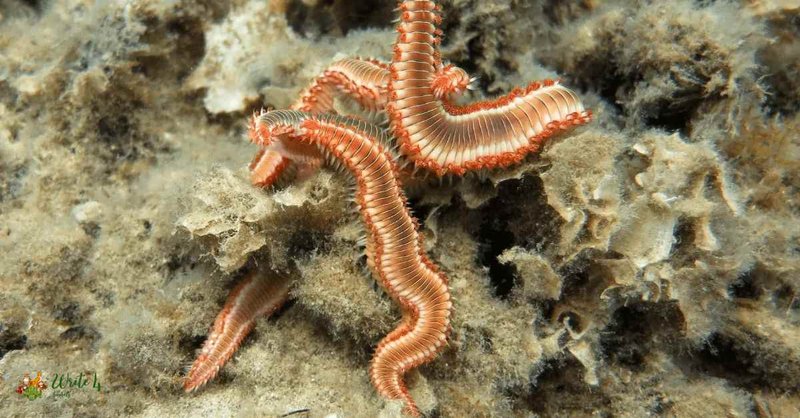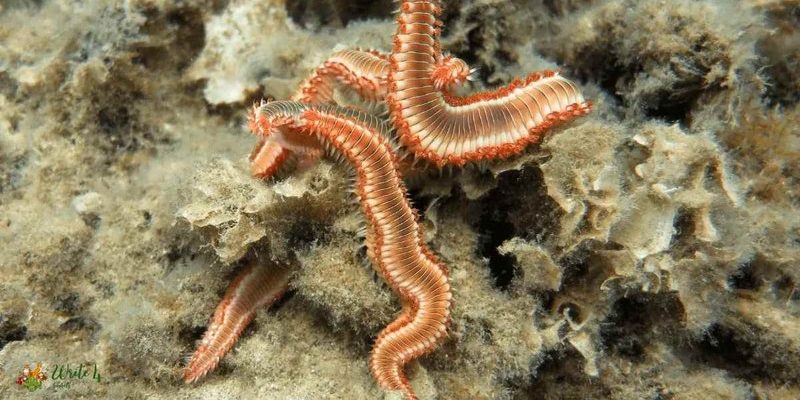
Bristle worms, often found in marine sediments, are fascinating creatures that contribute significantly to maintaining the health of underwater habitats. They have a unique anatomy that helps them thrive in various environments, from sandy bottoms to rocky shorelines. By understanding their role in nutrient cycling, we can appreciate how these small organisms have a big impact on marine life, even if we often overlook them.
What Are Bristle Worms?
Bristle worms, known scientifically as polychaetes, belong to the class Polychaeta. They’re segmented worms, often featuring bristles—hence the name—that help them move through their environment. With over 10,000 species, bristle worms can be found all over the globe in diverse habitats ranging from tidal flats to deep-sea trenches.
The bristles, also called chaetae, are made of chitin and serve various purposes. They aid in locomotion, helping the worms anchor themselves in sediment and navigate complex environments. You might be wondering how these creatures fit into the grand scheme of things in their habitats. Well, their role goes far beyond just existing in the sand—these worms are crucial for breaking down organic materials and cycling nutrients.
The Importance of Nutrient Cycling
Nutrient cycling is a fundamental process in ecosystems where nutrients move through different components, including the soil, water, and living organisms. Think of it as a big circle: nutrients are absorbed by plants, eaten by animals, and eventually returned to the soil when those organisms die or produce waste. This cycle is vital for sustaining life, as it ensures that essential nutrients like nitrogen and phosphorus are available for other organisms.
In marine environments, nutrient cycling can be especially crucial because it helps maintain the health of coral reefs, seagrasses, and other underwater ecosystems. When bristle worms break down organic matter, they release nutrients back into the water, making them available for plants and other organisms that need them to grow. Without these small but mighty worms, the nutrient balance in marine habitats could be dramatically affected.
How Bristle Worms Contribute to Nutrient Cycling
Bristle worms contribute to nutrient cycling through a few key processes. Their feeding habits are one of the most essential ways they help. These worms mostly consume decaying organic material, such as plant debris, dead animals, and feces. As they digest this material, they break it down further, making it more accessible for other organisms.
Additionally, bristle worms aerate the sediment as they burrow, which is another important aspect of nutrient cycling. This burrowing process allows oxygen to penetrate deeper into the sediment, creating a healthier environment for other organisms. With more oxygen available, bacteria can thrive, further breaking down organic matter and transforming it into nutrients that plants and other marine life can utilize.
By cycling nutrients through decomposition and aeration, bristle worms help create a balanced ecosystem that supports a diverse range of marine life. They’re like the backbone of the ocean floor, holding everything together.
The Role of Bristle Worms in Sediment Environments
Bristle worms thrive predominantly in sediment environments, where they play a critical role in the nutrient cycling process. In sandy and muddy areas, these worms contribute to the overall health of the ecosystem by breaking down organic materials and recycling nutrients back into the food web. Their presence can indicate a healthy sediment environment, as they thrive in areas with adequate food sources and oxygen.
In these environments, bristle worms also act as prey for various marine animals. Fish and other predators rely on these worms as a food source, underscoring their importance within the food web. By serving as both decomposers and prey, bristle worms maintain the delicate balance of life within their habitats.
Additionally, as they break down organic material, bristle worms enhance the quality of the sediment. This improved sediment is not only beneficial for other organisms but also supports the growth of seagrasses and corals, which rely on healthy substrates for their own growth.
Challenges Facing Bristle Worms and Nutrient Cycling
Despite their crucial role in nutrient cycling, bristle worms face various challenges that can threaten their populations and the ecosystems they support. One of the biggest challenges is human activity. Pollution, habitat destruction, and climate change are all affecting marine environments, and bristle worms are not immune to these impacts.
For example, excess nutrients from agricultural runoff can lead to algal blooms, which deplete oxygen levels in the water and create dead zones where bristle worms and other marine life struggle to survive. Moreover, habitat destruction due to coastal development can also reduce the environments where bristle worms thrive.
Ultimately, if bristle worm populations decline, the effects could ripple through the ecosystem. Without their nutrient cycling contributions, the health of marine environments could decline, impacting everything from fish populations to coral reefs.
Recognizing the Signs of Healthy Marine Ecosystems
You might be wondering how to recognize a healthy marine ecosystem, especially if it includes bristle worms. One key indicator is the diversity of life present in the area. A variety of species, including bristle worms, fish, and plant life, suggests a balanced and thriving environment.
Another sign is the clarity of the water. Clear water often indicates low nutrient pollution levels, which helps maintain healthy populations of bristle worms and other essential organisms. Lastly, the presence of seagrass beds or healthy coral reefs points to a well-functioning ecosystem, as these habitats rely heavily on the nutrient cycling that bristle worms provide.
Monitoring these signs can help researchers and conservationists ensure that marine habitats remain healthy and resilient against pressures like pollution and climate change.
Bristle worms may not grab headlines like dolphins or colorful reef fish, but they play a significant role in nutrient cycling within marine ecosystems. By breaking down organic matter and recycling nutrients, they support a healthy underwater world that sustains countless marine species. Understanding their importance helps us appreciate the complex web of life in our oceans and underscores the need for conservation efforts aimed at protecting these habitats.
Next time you think about the ocean, remember the bristle worms quietly working beneath the surface. They’re vital not just for their own survival but for the health of the entire ecosystem. Let’s keep these unsung heroes in mind as we work toward a healthier planet, because every tiny creature has its part to play in the grand design of nature.

